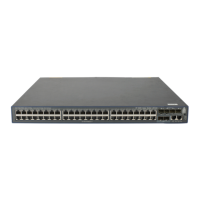30
NOTE:
The backup source IP address specified for outgoing RADIUS packets takes effect only when stateful
failover is configured, and it must be the source IP address for outgoing RADIUS packets that is confi
ured
on the standby switch.
Setting timers for controlling communication with RADIUS servers
The switch uses the following types of timers to control the communication with a RADIUS server:
• Server response timeout timer (response-timeout)—Defines the RADIUS request retransmission
interval. After sending a RADIUS request (authentication/authorization or accounting request), the
switch starts this timer. If the switch receives no response from the RADIUS server before this timer
expires, it resends the request.
• Server quiet timer (quiet)—Defines the duration to keep an unreachable server in blocked state. If
a server is not reachable, the switch changes the server’s status to blocked, starts this timer for the
server, and tries to communicate with another server in active state. After this timer expires, the
switch changes the status of the server back to active.
• Real-time accounting timer (realtime-accounting)—Defines the interval at which the switch sends
real-time accounting packets to the RADIUS accounting server for online users. To implement
real-time accounting, the switch must periodically send real-time accounting packets to the
accounting server for online users.
To set timers for controlling communication with RADIUS servers:
Step Command Remarks
1. Enter system view. system-view N/A
2. Enter RADIUS scheme view.
radius scheme
radius-scheme-name
N/A
3. Set the RADIUS server
response timeout timer.
timer response-timeout seconds
Optional.
The default RADIUS server
response timeout timer is 3
seconds.
4. Set the quiet timer for the
servers.
timer quiet minutes
Optional.
The quiet timer is 5 minutes.
5. Set the real-time accounting
timer.
timer realtime-accounting minutes
Optional.
The default real-time accounting
timer is 12 minutes.
• For a type of users, the maximum number of transmission attempts multiplied by the RADIUS server
response timeout period must be less than the client connection timeout time and must not exceed
75 seconds. Otherwise, stop-accounting messages cannot be buffered, and the
primary/secondary server switchover cannot take place. For example, the product of the two
parameters must be less than 10 seconds for voice users, and less than 30 seconds for Telnet users
because the client connection timeout period for voice users is 10 seconds and that for Telnet users
is 30 seconds.
• When you configure the maximum number of RADIUS packet transmission attempts and the
RADIUS server response timeout period, be sure to take the number of secondary servers into
account. If the retransmission process takes too much time, the client connection in the access
module may be timed out while the switch is trying to find an available server.

